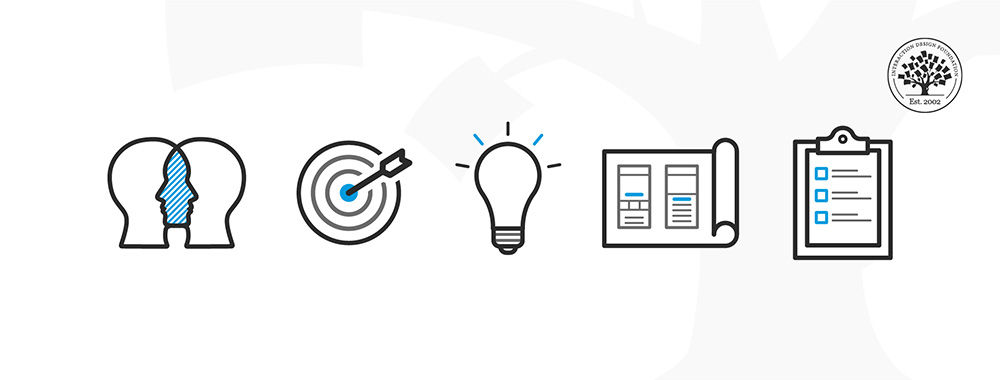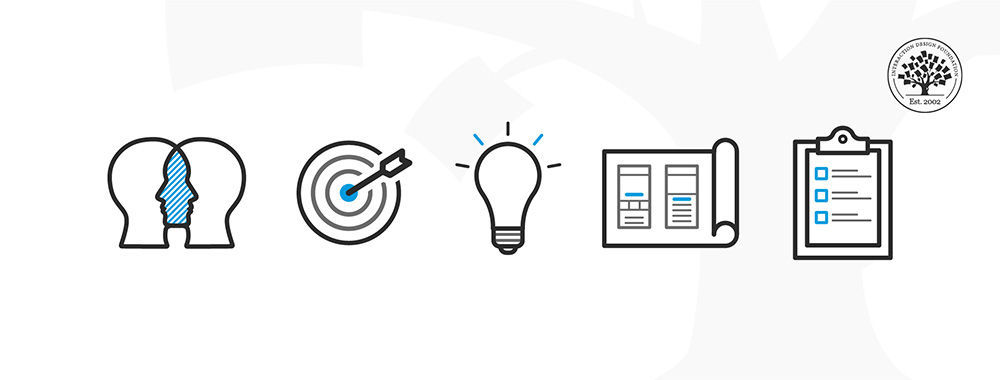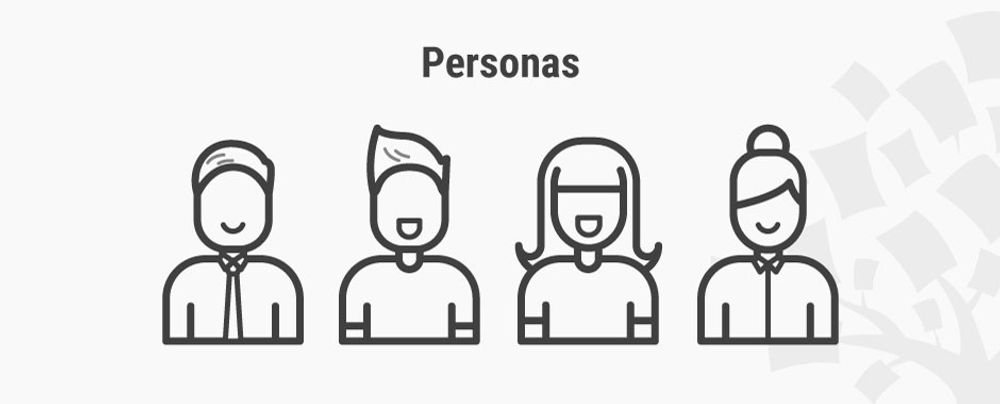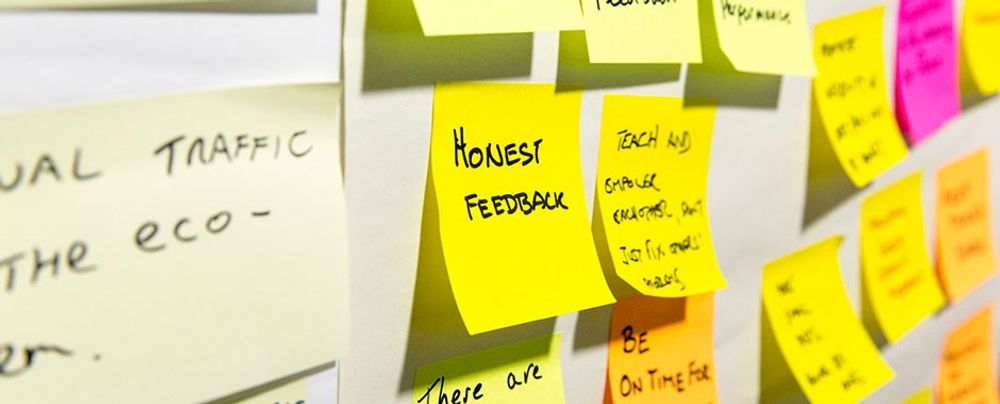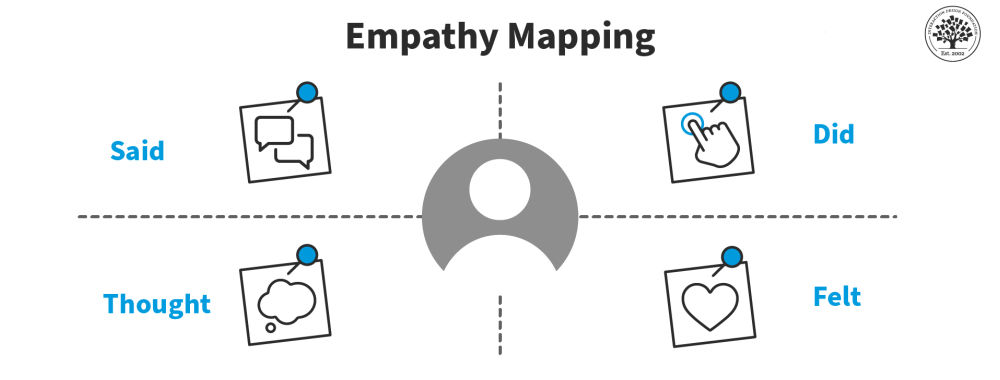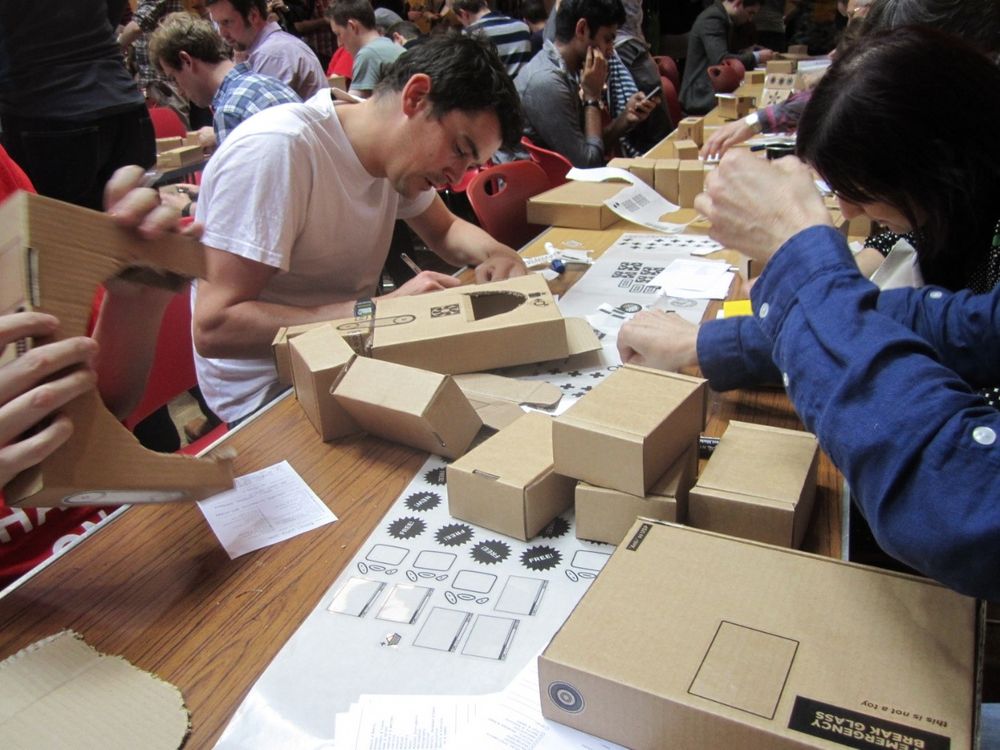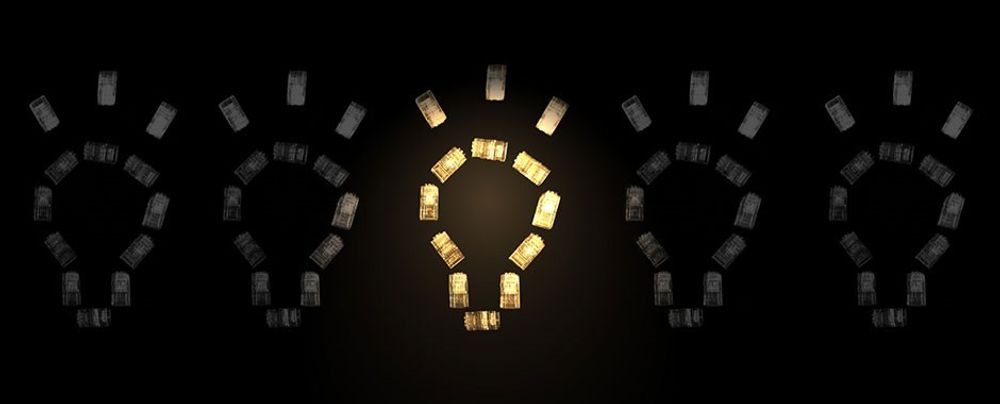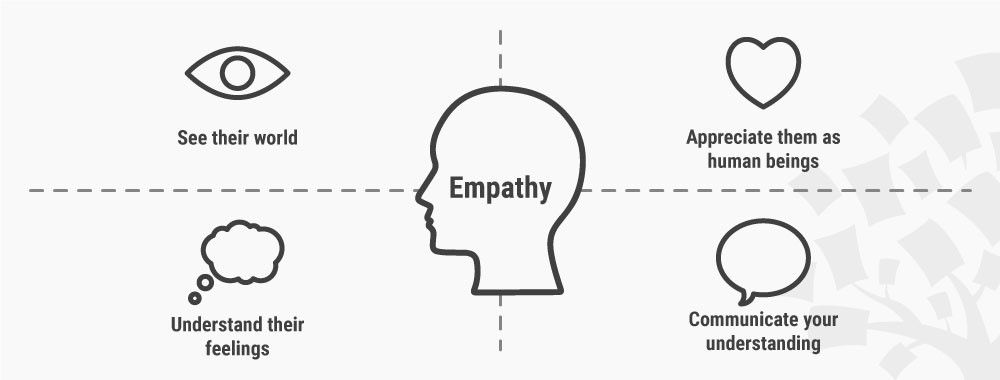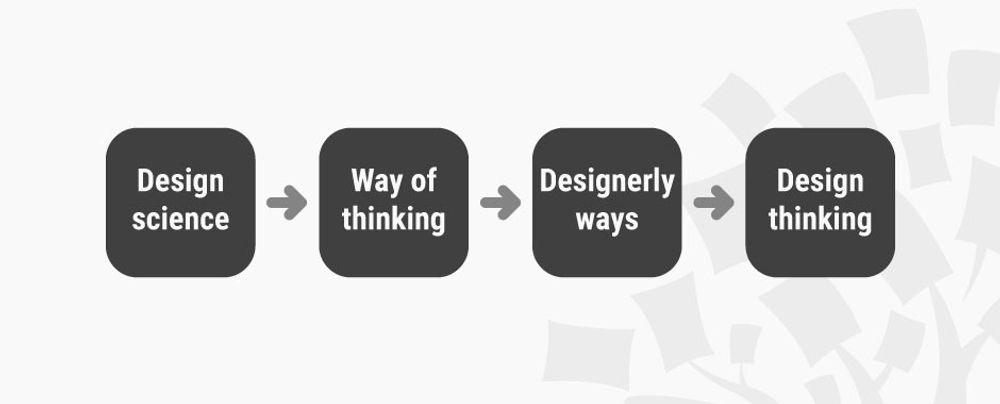Design Thinking is not an exclusive property of designers—all great innovators in literature, art, music, science, engineering, and business have practiced it. So, why call it Design Thinking? What’s special about Design Thinking is that designers’ work processes can help us systematically extract, teach, learn and apply these human-centered techniques to solve problems in a creative and innovative way—in our designs, in our businesses, in our countries, in our lives.
Some of the world’s leading brands, such as Apple, Google and Samsung, rapidly adopted the design thinking approach, and leading universities around the world teach the related methodology—including Stanford, Harvard, Imperial College London and the Srishti Institute in India. Before you incorporate design thinking into your own workflows, you need to know what it is and why it’s so popular. Here, we’ll cut to the chase and tell you what design thinking is all about and why it’s so in demand.
What is Design Thinking?
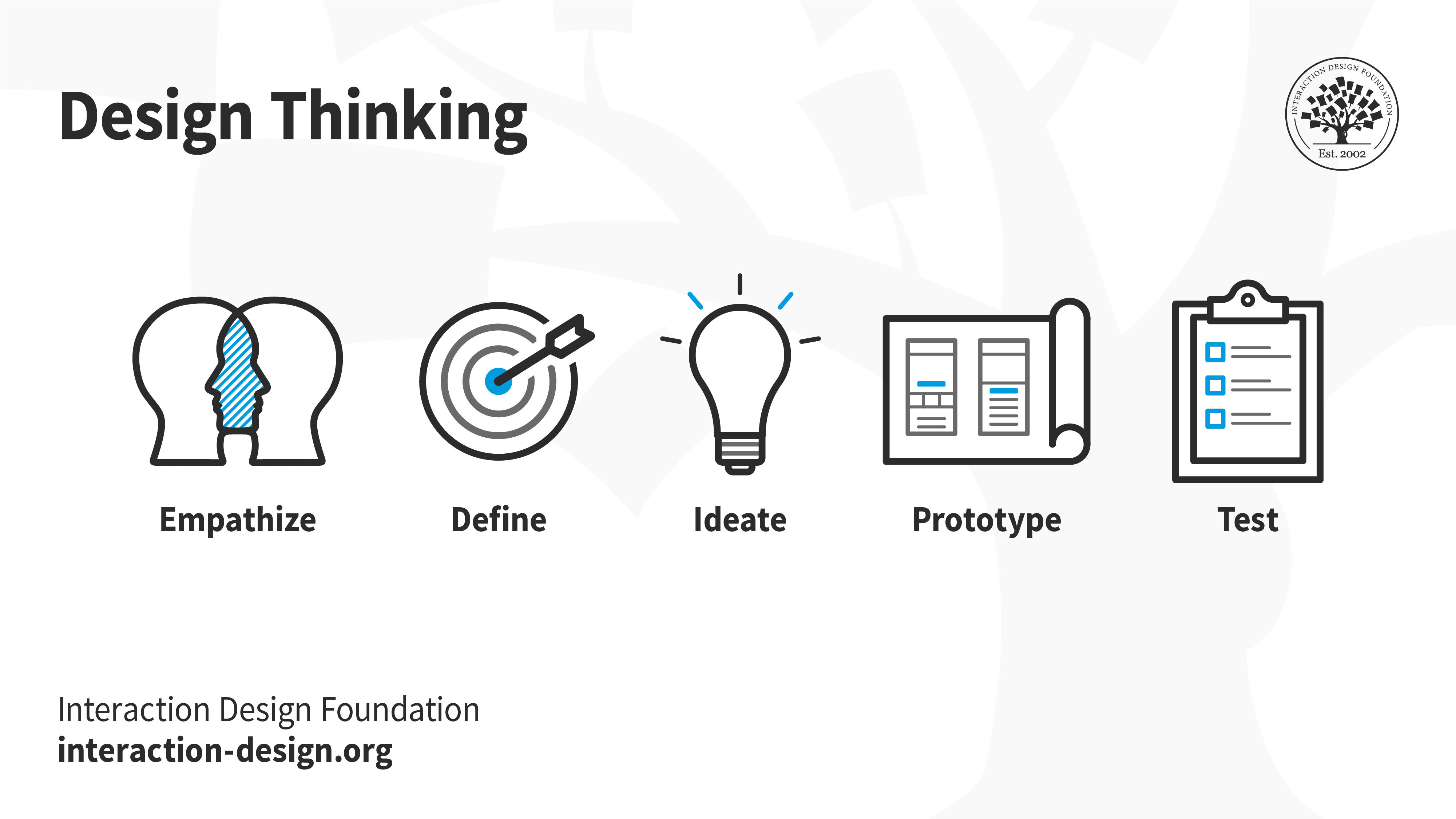
Design thinking is an iterative and non-linear process that contains five phases: 1. Empathize, 2. Define, 3. Ideate, 4. Prototype and 5. Test.
Design thinking is an iterative process in which you seek to understand your users, challenge assumptions, redefine problems and create innovative solutions which you can prototype and test. The overall goal is to identify alternative strategies and solutions that are not instantly apparent with your initial level of understanding.
Design thinking is more than just a process; it opens up an entirely new way to think, and it offers a collection of hands-on methods to help you apply this new mindset.
In essence, design thinking:
Revolves around a deep interest to understand the people for whom we design products and services.
Helps us observe and develop empathy with the target users.
Enhances our ability to question: in design thinking you question the problem, the assumptions and the implications.
Proves extremely useful when you tackle problems that are ill-defined or unknown.
Involves ongoing experimentation through sketches, prototypes, testing and trials of new concepts and ideas.
In this video, Don Norman, the Grandfather of Human-Centered Design, explains how the approach and flexibility of design thinking can help us tackle major global challenges.
What Are the 5 Phases of Design Thinking?
Video copyright info
Hasso-Platner Institute Panorama
Ludwig Wilhelm Wall, CC BY-SA 3.0 <https://creativecommons.org/licenses/by-sa/3.0>, via Wikimedia Commons
Design thinking is an iterative and non-linear process that contains five phases: 1. Empathize, 2. Define, 3. Ideate, 4. Prototype and 5. Test. You can carry these stages out in parallel, repeat them and circle back to a previous stage at any point in the process.
The core purpose of the process is to allow you to work in a dynamic way to develop and launch innovative ideas.
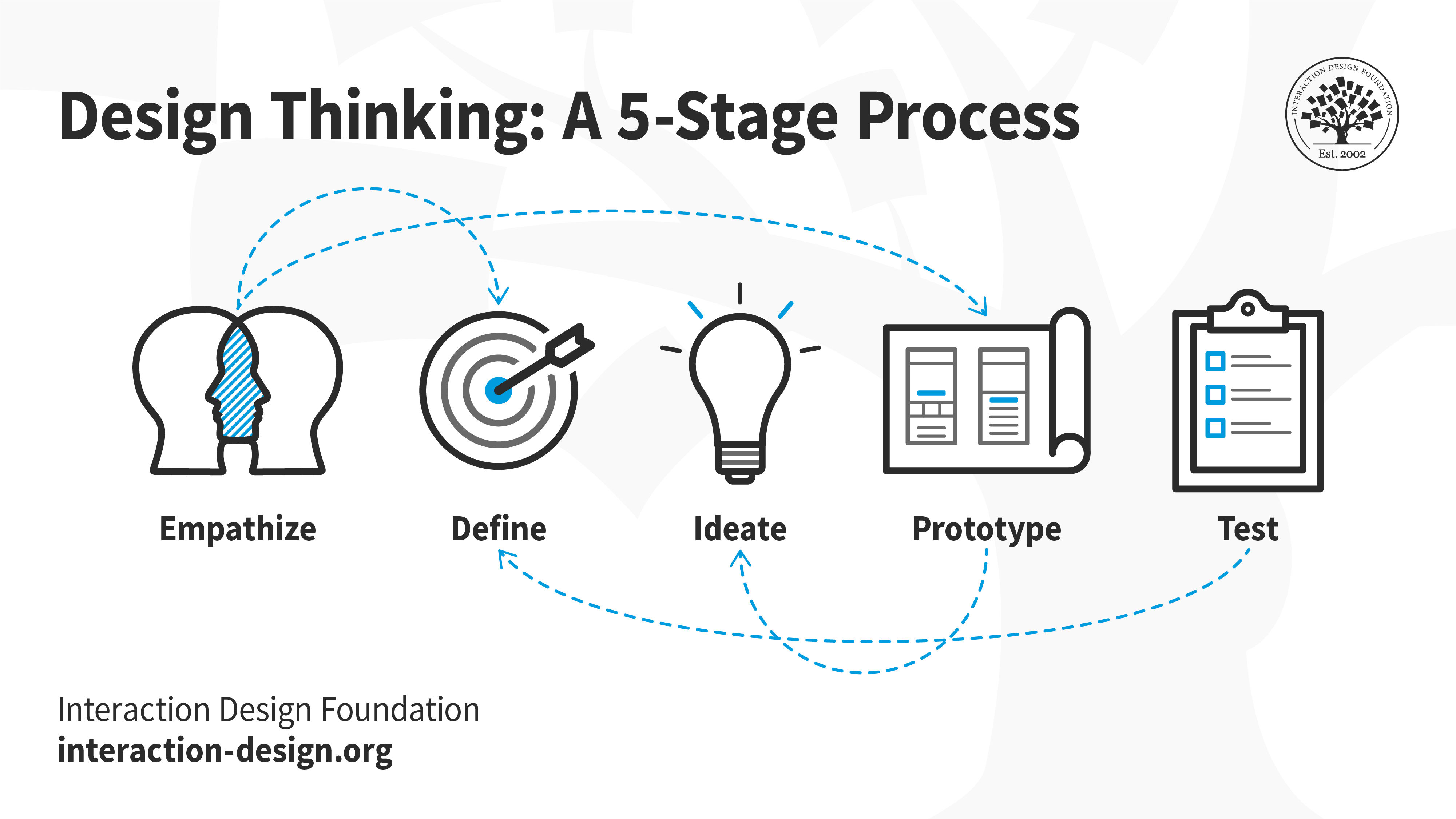
Design thinking is an iterative and non-linear process that contains five phases: 1. Empathize, 2. Define, 3. Ideate, 4. Prototype and 5. Test.
Design Thinking Makes You Think Outside the Box
Design thinking can help people do out-of-the-box or outside-the-box thinking. People who use this methodology:
Attempt to develop new ways of thinking—ways that do not abide by the dominant or more common problem-solving methods.
Have the intention to improve products, services and processes. They seek to analyze and understand how users interact with products to investigate the conditions in which they operate.
Ask significant questions and challenge assumptions. One element of outside-the-box / out-of-the-box thinking is to to make previous assumptions falsifiable—i.e., make it possible to prove whether they’re valid or not.
As you can see, design thinking offers us a means to think outside the box and also dig that bit deeper into problem-solving. It helps us carry out the right kind of research, create prototypes and test our products and services to uncover new ways to meet our users’ needs.
The Grand Old Man of User Experience, Don Norman, who also coined the very term User Experience, explains what Design Thinking is and what’s so special about it:
“…the more I pondered the nature of design and reflected on my recent encounters with engineers, business people and others who blindly solved the problems they thought they were facing without question or further study, I realized that these people could benefit from a good dose of design thinking. Designers have developed a number of techniques to avoid being captured by too facile a solution. They take the original problem as a suggestion, not as a final statement, then think broadly about what the real issues underlying this problem statement might really be (for example by using the "Five Whys" approach to get at root causes). Most important of all, is that the process is iterative and expansive. Designers resist the temptation to jump immediately to a solution to the stated problem. Instead, they first spend time determining what the basic, fundamental (root) issue is that needs to be addressed. They don't try to search for a solution until they have determined the real problem, and even then, instead of solving that problem, they stop to consider a wide range of potential solutions. Only then will they finally converge upon their proposal. This process is called "Design Thinking."
— Don Norman, Rethinking Design Thinking
Design Thinking is for Everybody
How many people are involved in the design process when your organization decides to create a new product or service? Teams that build products are often composed of people from a variety of different departments. For this reason, it can be difficult to develop, categorize and organize ideas and solutions for the problems you try to solve. One way you can keep a project on track, and organize the core ideas, is to use a design thinking approach—and everybody can get involved in that!
Tim Brown, CEO of the celebrated innovation and design firm IDEO, emphasizes this in his successful book Change by Design when he says design thinking techniques and strategies belong at every level of a business.
Design thinking is not only for designers but also for creative employees, freelancers and leaders who seek to infuse it into every level of an organization. This widespread adoption of design thinking will drive the creation of alternative products and services for both business and society.
“Design thinking begins with skills designers have learned over many decades in their quest to match human needs with available technical resources within the practical constraints of business. By integrating what is desirable from a human point of view with what is technologically feasible and economically viable, designers have been able to create the products we enjoy today. Design thinking takes the next step, which is to put these tools into the hands of people who may have never thought of themselves as designers and apply them to a vastly greater range of problems.”
— Tim Brown, Change by Design, Introduction
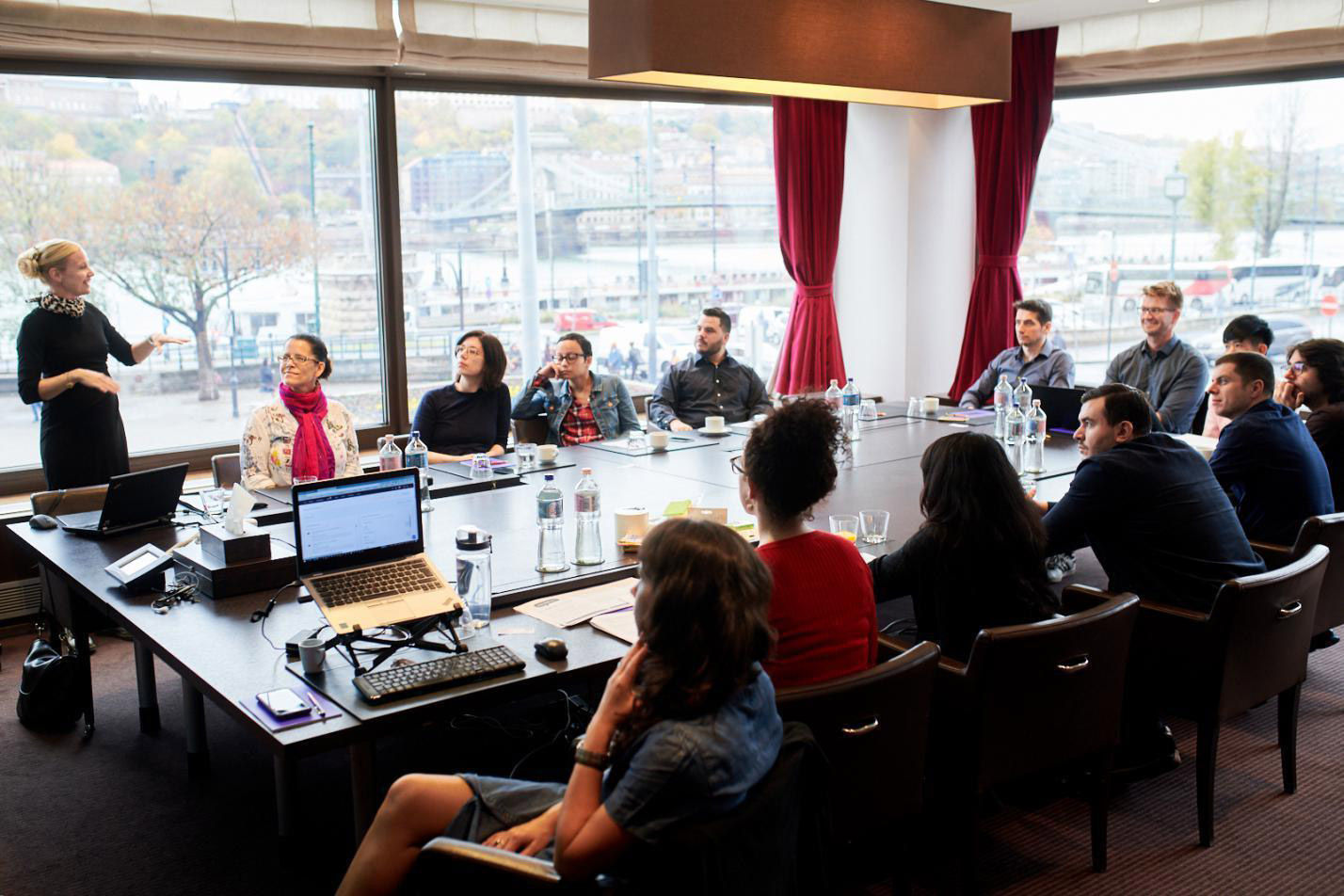
Design thinking techniques and strategies belong at every level of a business. You should involve colleagues from a wide range of departments to create a cross-functional team that can utilize knowledge and experience from different specialisms.
Tim Brown also shows how design thinking is not just for everybody—it’s about everybody, too. The process is firmly based on how you can generate a holistic and empathic understanding of the problems people face. Design thinking involves ambiguous, and inherently subjective, concepts such as emotions, needs, motivations and drivers of behavior.
In a solely scientific approach (for example, analyzing data), people are reduced to representative numbers, devoid of emotions. Design thinking, on the other hand, considers both quantitative as well as qualitative dimensions to gain a more complete understanding of user needs. For example, you might observe people performing a task such as shopping for groceries, and you might talk to a few shoppers who feel frustrated with the checkout process at the store (qualitative data). You can also ask them how many times a week they go shopping or feel a certain way at the checkout counter (quantitative data). You can then combine these data points to paint a holistic picture of user pain points, needs and problems.
Tim Brown sums up that design thinking provides a third way to look at problems. It’s essentially a problem-solving approach that has crystallized in the field of design to combine a holistic user-centered perspective with rational and analytical research—all with the goal to create innovative solutions.
“Design thinking taps into capacities we all have but that are overlooked by more conventional problem-solving practices. It is not only human-centered; it is deeply human in and of itself. Design thinking relies on our ability to be intuitive, to recognize patterns, to construct ideas that have emotional meaning as well as functionality, to express ourselves in media other than words or symbols. Nobody wants to run a business based on feeling, intuition, and inspiration, but an overreliance on the rational and the analytical can be just as dangerous. The integrated approach at the core of the design process suggests a ‘third way.’”
— Tim Brown, Change by Design, Introduction
Design Thinking Has a Scientific Side
Design thinking is both an art and a science. It combines investigations into ambiguous elements of the problem with rational and analytical research—the scientific side in other words. This magical concoction reveals previously unknown parameters and helps to uncover alternative strategies which lead to truly innovative solutions.
The scientific activities analyze how users interact with products, and investigate the conditions in which they operate. They include tasks which:
Research users’ needs.
Pool experience from previous projects.
Consider present and future conditions specific to the product.
Test the parameters of the problem.
Test the practical application of alternative problem solutions.
Once you arrive at a number of potential solutions, the selection process is then underpinned by rationality. As a designer, you are encouraged to analyze and falsify these solutions to arrive at the best available option for each problem or obstacle identified during phases of the design process.
With this in mind, it may be more correct to say design thinking is not about thinking outside the box, but on its edge, its corner, its flap, and under its bar code—as Clint Runge put it.
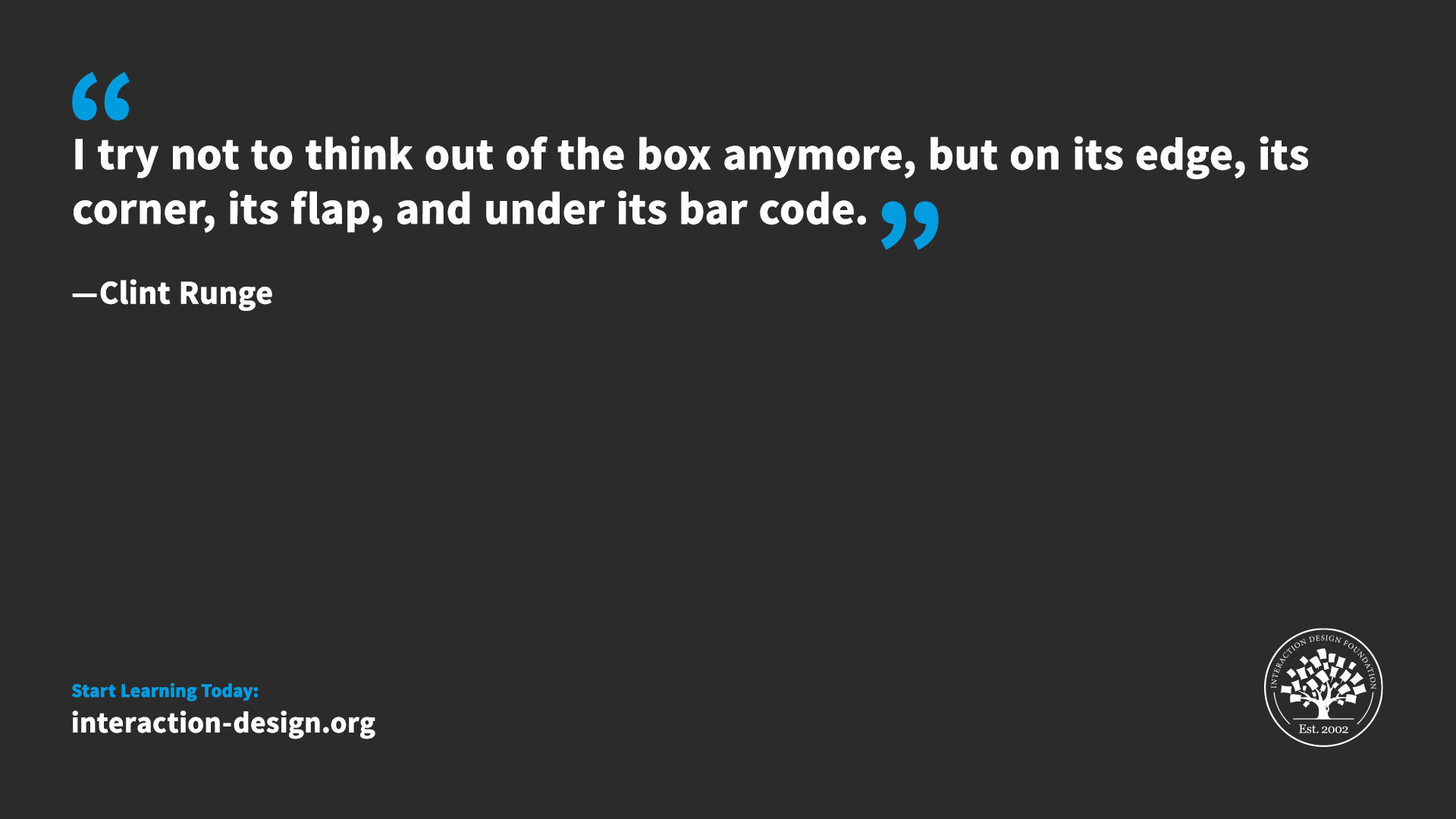
Clint Runge is Founder and Managing Director of Archrival, a distinguished youth marketing agency, and adjunct Professor at the University of Nebraska-Lincoln.
Resetting Our Mental Boxes and Developing a Fresh Mindset
Thinking outside of the box can provide an innovative solution to a sticky problem. However, thinking outside of the box can be a real challenge as we naturally develop patterns of thinking that are modeled on the repetitive activities and commonly accessed knowledge we surround ourselves with.
Some years ago, an incident occurred where a truck driver tried to pass under a low bridge. But he failed, and the truck was lodged firmly under the bridge. The driver was unable to continue driving through or reverse out.
The story goes that as the truck became stuck, it caused massive traffic problems, which resulted in emergency personnel, engineers, firefighters and truck drivers gathering to devise and negotiate various solutions for dislodging the trapped vehicle.
Emergency workers were debating whether to dismantle parts of the truck or chip away at parts of the bridge. Each spoke of a solution that fitted within his or her respective level of expertise.
A boy walking by and witnessing the intense debate looked at the truck, at the bridge, then looked at the road and said nonchalantly, “Why not just let the air out of the tires?” to the absolute amazement of all the specialists and experts trying to unpick the problem.
When the solution was tested, the truck was able to drive free with ease, having suffered only the damage caused by its initial attempt to pass underneath the bridge. The story symbolizes the struggles we face where oftentimes the most obvious solutions are the ones hardest to come by because of the self-imposed constraints we work within.

It’s often difficult for us humans to challenge our assumptions and everyday knowledge because we rely on building patterns of thinking in order to not have to learn everything from scratch every time. We rely on doing everyday processes more or less unconsciously—for example, when we get up in the morning, eat, walk, and read—but also when we assess challenges at work and in our private lives. In particular, experts and specialists rely on their solid thought patterns, and it can be very challenging and difficult for experts to start questioning their knowledge.
Stories Have the Power to Inspire
Why did we tell you this story about the truck and the bridge? Well, it’s because stories can help us inspire opportunities, ideas and solutions. Stories are framed around real people and their lives and are important because they’re accounts of specific events, not general statements. They provide us with concrete details which help us imagine solutions to particular problems.
Stories also help you develop the eye of a designer. As you walk around the world, you should try to look for the design stories that are all around you. Say to yourself “that’s an example of great design” or “that's an example of really bad design” and try to figure out the reasons why.
When you come across something particularly significant, make sure you document it either through photos or video. This will prove beneficial not only to you and your design practice but also to others—your future clients, maybe.
The Take Away
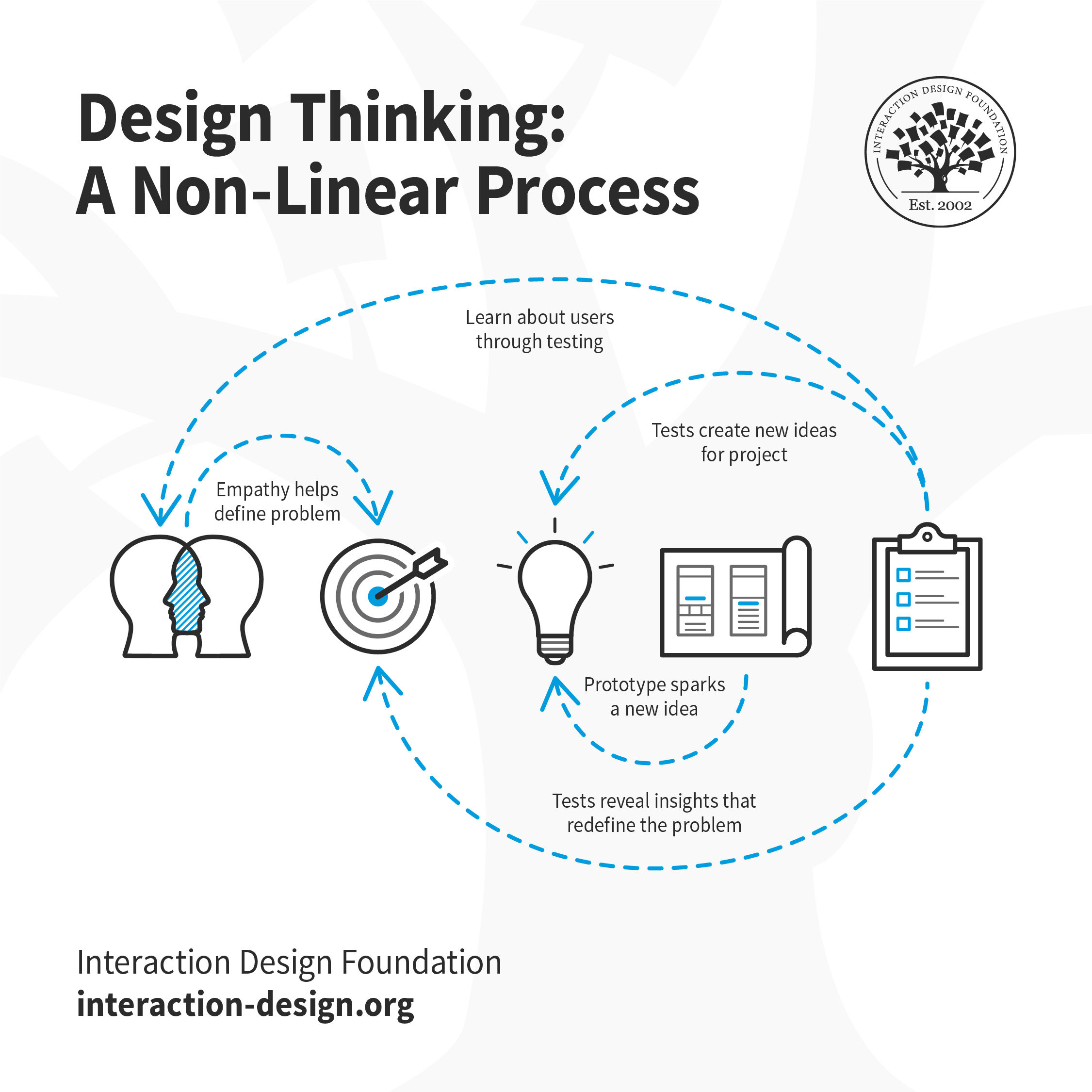
Design Thinking is an iterative and non-linear process. This simply means that the design team continuously uses their results to review, question and improve their initial assumptions, understandings and results. Results from the final stage of the initial work process inform our understanding of the problem, help us determine the parameters of the problem, enable us to redefine the problem, and, perhaps most importantly, provide us with new insights so we can see any alternative solutions that might not have been available with our previous level of understanding.
Design thinking is a non-linear, iterative process that consists of 5 phases: 1. Empathize, 2. Define, 3. Ideate, 4. Prototype and 5. Test. You can carry out the stages in parallel, repeat them and circle back to a previous stage at any point in the process—you don’t have to follow them in order.
It’s a process that digs a bit deeper into problem-solving as you seek to understand your users, challenge assumptions and redefine problems. The design thinking process has both a scientific and artistic side to it, as it asks us to understand and challenge our natural, restrictive patterns of thinking and generate innovative solutions to the problems our users face.
Design thinking is essentially a problem-solving approach that has the intention to improve products. It helps you assess and analyze known aspects of a problem and identify the more ambiguous or peripheral factors that contribute to the conditions of a problem. This contrasts with a more scientific approach where the concrete and known aspects are tested in order to arrive at a solution.
The iterative and ideation-oriented nature of design thinking means we constantly question and acquire knowledge throughout the process. This helps us redefine a problem so we can identify alternative strategies and solutions that aren’t instantly apparent with our initial level of understanding.
Design thinking is often referred to as outside-the-box thinking, as designers attempt to develop new ways of thinking that do not abide by the dominant or more common problem-solving methods—just like artists do.
The design thinking process has become increasingly popular over the last few decades because it was key to the success of many high-profile, global organizations. This outside-the-box thinking is now taught at leading universities across the world and is encouraged at every level of business.
“The ‘Design Thinking’ label is not a myth. It is a description of the application of well-tried design process to new challenges and opportunities, used by people from both design and non-design backgrounds. I welcome the recognition of the term and hope that its use continues to expand and be more universally understood, so that eventually every leader knows how to use design and design thinking for innovation and better results.”
— Bill Moggridge, co-founder of IDEO, in Design Thinking: Dear Don
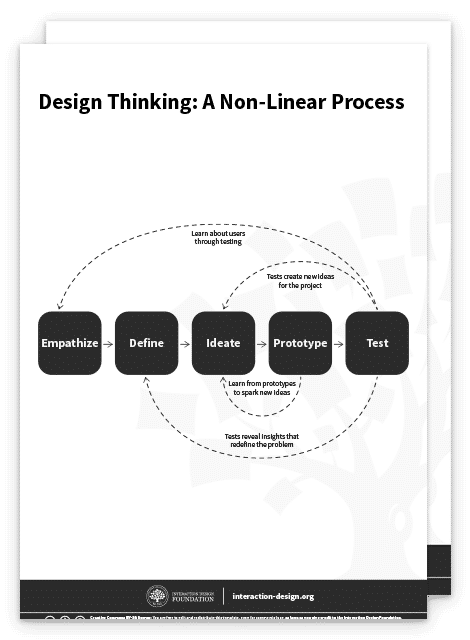

References & Where to Learn More
Enroll in our engaging course, “Design Thinking: The Ultimate Guide”
Here are some examples of good and bad designs to inspire you to look for examples in your daily life.
Read this informative article “What Is Design Thinking, and How Can SMBs Accomplish It?” by Jackie Dove.
Read this insightful article “Rethinking Design Thinking” by Don Norman.
Check out Tim Brown’s book “Change by Design: How Design Thinking Transforms Organizations and Inspires Innovation Introduction,” 2009.
Learn more about Design Thinking in the article “Design Thinking: Dear Don” by Bill Moggridge.
Images
© Interaction Design Foundation, CC BY-SA 3.0
